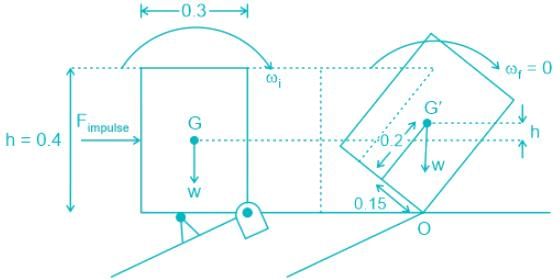Test: Impulse and Momentum - Mechanical Engineering MCQ
10 Questions MCQ Test - Test: Impulse and Momentum
During elastic and inelastic collision, ________ is conserved.
Two balls of equal mass and of Perfectly elastic material are lying on the floor. One of the balls with velocity V is made to strike the second ball. Both the balls after impact will move with a velocity
During Perfectly Elastic Collision between two bodies, which of the following quantities always remains conserved?
Calculate the velocity of a body having a mass of 9 kg and linear momentum of 63 kg m/s.
The kinetic energy of a body is stated to increase by 300 percent. The corresponding increase in the momentum of the body will be ____%
A rigid homogeneous uniform block of mass 1 kg, height h = 0.4 m and width b = 0.3 m is pinned at one corner and placed upright in a uniform gravitational field (g = 9.81 m/s2), supported by a roller in the configuration shown in the figure. A short duration (impulsive) force F, producing an impulse IF is applied at a height of d = 0.3 m from the bottom as shown. Assume all joints to be frictionless. The minimum value of IF required to topple the block is

The rate of change of momentum is equal to the applied force and it takes place in the direction of the force is a statement of:
A 1.0 kg ball drops vertically onto the floor with a speed of 25 m/s. It rebounds with an initial speed of 10 m/s. The impulse action on the ball during contact will be
If the momentum of a body increases from 10 units to 25 units in 5 sec, then the force acting on it is
Two inelastic spheres of masses 10 kg each move with velocities of 15 m/s and 5 m/s respectively in the same direction. The loss in kinetic energy when they collide



























